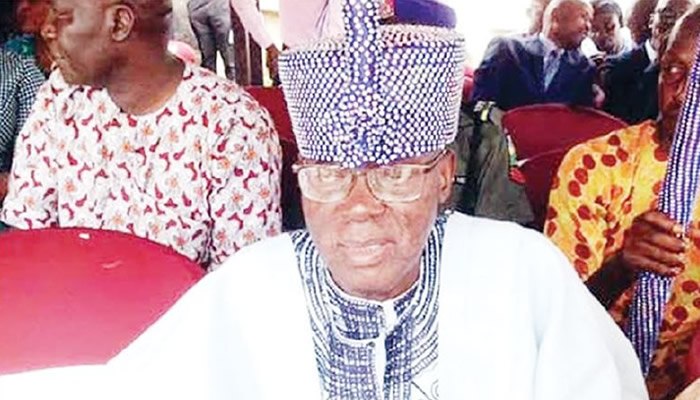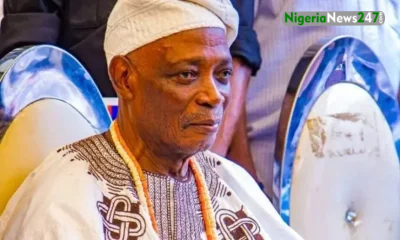METRO
89 Years After His Christening, Olakulehin Ascends the Olubadan Throne Today

Today, Oba Owolabi Olakulehin officially ascends to the throne as the Olubadan of Ibadan land. In this piece, Laolu Afolabi highlights the monarch’s humble beginnings, his journey to the throne, the unique nature of the Ibadan non-ruling house chieftaincy, and the symbolic coronation ceremony that coincides with the new monarch’s christening date.
On July 5, 1935, a charming boy was born in the serene Okugbaja Village, located near Akanran in what is now the Ona Ara Local Government Area of Oyo State, Nigeria. The joyous occasion was celebrated by his proud parents, Pa Ishola-Okin Owolabi and Madam Adunola Aweni Ope Ajilaran Omoyoade Owolabi. Following the rich and time-honoured Yoruba tradition, the family waited until the eighth day after his birth to officially bestow upon him his name. In a ceremony held within the family compound on July 12, he was given the name Akinloye Olalere Owolabi Olakulehin. The name, rich with cultural significance and family heritage, marked the beginning of his journey in life.
Today, on another July 12 and the 89th anniversary of his christening, the boy once known as Baby Olakulehin is set to ascend to one of the highest traditional titles in Yoruba land. In a grand ceremony at the historic Mapo Hall, he will be enthroned as the Olubadan of Ibadanland. This significant event will see him don the prestigious beaded crown, symbolising his new status and authority. With this ascension, he will be officially titled His Imperial Majesty, marking a momentous occasion not only for him and his family but also for the entire community that holds the Olubadan title in high esteem.
The coronation will be witnessed by the crème-de-la-crème and the influential personalities in the country and beyond, as opposed to the family compound naming ceremony held 89 years ago. Dignitaries led by President Bola Tinubu, governors, ministers, eminent traditional rulers, captains of industries, and academics, among others, will witness the coronation of the 43rd Olubadan in history, at the historic Mapo Hall, built in 1929, six years before the birth of the new Ibadan monarch. Today, on another christening anniversary, Olakulehin will lift the banner of his ancestors, being the first from his lineage to become the Olubadan. He has chosen to bear the name of the family, Olubadan Owolabi Olakulehin, Ige Olakulehin 1.
In honour of this historic christening, the Babaloja General of Oyo State, Alhaji Yekeen Abass, ordered markets in Ibadanland to be shut today between 7 am and 2 pm, in honour of the new Olubadan of Ibadanland. To demonstrate that it was beyond the family compound christening, the Babaloja said the closure of the markets is to give honour to the first class Oba and allow the free flow of traffic. He then asked all market traders and leaders to move en masse to Mapo Hall, the venue of the presentation of the instrument of office to the new monarch.
Another honour for the new Olubadan of Ibadanland is that he would be the second Olubadan to rule from a befitting palace, after the famous Olubadan Yesufu Oloyede Asanike, who first lived in the old palace at Oja’ba. The ultramodern historic palace, sitting magnificently on Oke-Aremo and inaugurated by Governor Seyi Makinde on Wednesday, is to be the new official residence and palace of subsequent Olubadans, starting with Oba Olakulehin. Hitherto, the personal residence of the succeeding Olubadan had always served as the palace, upon ascension to the throne.
Oba Olakulehin’s coronation is a significant blessing to Ita-Baale Olugbode, his ancestral homestead within the ancient city of Ibadan. This momentous event revives a historic lineage, as the last ruler from Ita-Baale was Baale Ajayi Oyesile Olugbode, who reigned from 1851 to 1864. The name “Ita-Baale” literally means the courtyard of the ruler, derived after the title of Baale Olugbode. It is noteworthy that since the title “Olubadan” was officially created in 1930, the Ita-Baale Olugbode area had not produced an Olubadan until now. The community holds a special place in the history of Ibadan, not only for its ancestral significance as a conglomeration of families in Ibadan but also for its religious heritage. It is renowned for being where Olubadan Akinyele established his church, the Christ Apostolic Church Olugbode. This church remains a prominent landmark, reflecting the deep-rooted spiritual and cultural heritage of the community. With Oba Olakulehin ascending the throne, Ita-Baale Olugbode is poised to regain its historical prominence, celebrating a new chapter in its rich legacy and contributing to the enduring story of Ibadan’s traditional leadership.
Oba Olakulehin is royalty personified. Both parents are from the established Ibadan recognised chieftaincy families. His maternal lineage derives from the Kusidi Family, whose ancestral farmland is in Kusidi Village in Egbeda Local Government Area. Their ancestral homestead is within the ancient metropolis of Ibadan at Ile Kusidi in Elekuro.
Every Ibadan family is rooted in a dual heritage comprising both an ancestral farmland and an ancestral homestead. This tradition signifies that every Ibadan indigene has a village and a family compound within the city. For the members of the Olakulehin family, their ancestral village, where a Baale (village head) presides, is located at Okugbaja, within the Akanran area. Their ancestral homestead, however, is situated at Ita-Baale Olugbode, which holds profound significance as the place where Oba Olakulehin began his journey towards becoming the Olubadan, starting as Mogaji (family head) of the Ige Olakulehin family.
In the societal structure of Ibadan, the position of Mogaji is held in high esteem and is considered senior to that of the Baale. The Baale is an appointee of the Mogaji, underscoring the authority and respect commanded by the family head. This hierarchical distinction highlights the Mogaji’s pivotal role in both the governance of the family and the broader community. For Oba Olakulehin, his ascent to the Olubadan throne is deeply intertwined with these familial and cultural traditions. His leadership journey commenced as Mogaji of the Ige Olakulehin Family of Ita-Baale Olugbode.
A Mogaji will begin the journey to become the Olubadan the day he becomes Jagun Olubadan or Jagun Balogun, depending on where the vacancy exists. There are two lines to the Olubadan, the Otun line (civil) and the Balogun line (warrior). The Otun line has 22 steps to climb to become the Olubadan, while the Balogun line has 23 rungs to the zenith. To emerge as Jagun on either line is a Herculean task and very competitive. It is a battle royale for all family heads contesting for a space.
For Olubadan Olakulehin, he became the Mogaji for the Ige Olakulehin Family of Ita-Baale Olugbode in Ibadan North-East Local Government Area of Oyo State, in 1983. He was installed as the Jagun Balogun of Ibadan land by Oba Asanike in 1986. He then rose through the ladder and was elevated in 2006 to the Olubadan-In-Council, under Oba Yinusa Bankole Ogundipe, the 38th Olubadan of Ibadan. In 2016, Oba Olakulehin became the Balogun of Ibadanland, following the promotion of Oba Saliu Adetunji to the throne of the Olubadan. Olakulehin served as Balogun of Ibadanland for eight years.
A member of the Olubadan-in-Council qualifies to serve as the head of the traditional council in various local government areas across Ibadan. Royalty begins as any chief of the Olubadan becomes the High Chief, following the emergence at the Ekaarun Olubadan or Ekaarun Balogun rungs of the ladders. The council comprises the Olubadan, Otun Olubadan, Balogun, Otun Balogun, Osi Olubadan, Osi Balogun, Ashipa Olubadan, Ashipa Balogun, Ekerin Olubadan, Ekerin Balogun, Ekarun Olubadan, Ekarun Balogun, and the Iyalode. Aside from the Olubadan and the Iyalode, the other 11 members are to serve as heads of traditional councils in the 11 local government areas of Ibadanland. The Iyalode is the head of all women’s affairs in the land.
For Oba Olakulehin, it was a journey of 38 years from Jagun Balogun – Ajia – Bada – Aare Onibon – Gbonnka – Aare Egbe Omo-Oota – Lagunna – Aare Ago – Ayingun – Asaju – Ikolaba – Aare Alasa – Agba Akin – Ekefa – Maye – Abese – Ekaarun Balogun – Ekeerin Balogun –














![Top Nigeria Newspaper Headlines Today 25th June 2024 [Tuesday] 87 Nigeria Newspaper Headlines](https://nigerianews247.com/wp-content/uploads/2024/04/Nigeria-Newspaper-Headlines-80x80.png)

![[VIDEO] Tinubu Stumbles while Boarding Presidential Parade Vehicle at Eagles Square 90 Tinubu Stumbles while Boarding Presidential Parade Vehicle at Eagles Square](https://nigerianews247.com/wp-content/uploads/2024/06/Tinubu-Stumbles-while-Boarding-Presidential-Parade-Vehicle-at-Eagles-Square-80x80.jpeg)


You must be logged in to post a comment Login